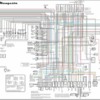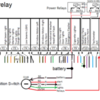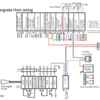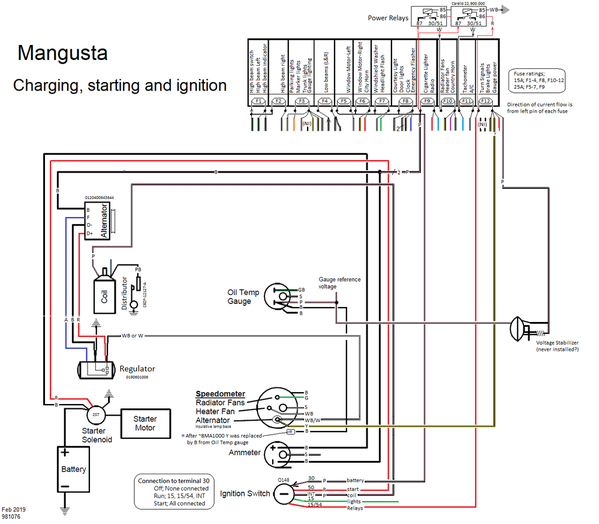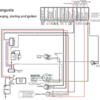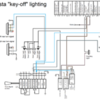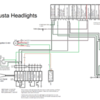Guys, lots of questions we had while putting together details, always appreciate if someone can help us fill in the blanks. The drawing now represents everything we could pull together, from the factory drawings (the "Italian" factory drawing dated November 1968, the undated but we assume earlier Hall trace, the Goose parts manual--but then every picture we could find of the Goose, other same-era wiring diagrams (esp Fiat 850/124, Lotus, MGB, and especially the Maserati Mexico/Mistral/Ghibli GT family which lent their fuse box to the Goose. Lastly, 5 cars that are/were physically in our own hands---but 4 of these 5 all from the 8ma10xx production range, and we're especially curious if there were changes after ~8ma1100 and especially the last German cars.
1. Headlight "flash"; Are "brights" with stalk forward or middle ? We've had at least one confirmation (from Denis' German made 1244) that stalk forward turns on brights, but 2 other cars where stalk forward=low beams. Also, the "Italian" drawing and manual show a Carello relay used for turning on Low beams whenever flash (stalk pulled back). How does your car work ?
2. Window motors; late Goose and Pantera had "2 wire" window motors, but 3 wire motors were clearly used on earlier cars. We assume that the transition occurred around ~8ma810 (with the change from the Ducellier chrome bezel pair-of-paddle switches to the stainless bezel 2-each Ducellier switches). Any idea ? We'd like to capture wire colors and also confirm the grounding position on the Black wire inside the door on the 2-wire cars.
3. City horn; We only know of the Bosch IGM3572 for the City horn, most cars used these in pairs with low of 270hz (around a C-sharp) and 400hz (around a G-sharp) but the Goose had only one. What's in your car ?
4. Options that never were...Seemed to come from the Maserati drawings.
a. Parking brake light did exist on very few cars, as we can tell a handful of the earliest (508, 518) and then the much later Bordinat car. Lotus Elan used the same parking brake umbrella handle and the S2 had used a Lotus switch on the umbrella bracket, would love to see any pictures of Goose parking brake switches. The lamp itself looks like the variant used for Mistral.
b. Alternator; seems to have been Prestolite (with 4 wire voltage regulator) on maybe the first ~50 cars, then moved to Bosch. Can anybody confirm this?
c. Reverse lights; as we can tell were implemented only on the Pantera.
c. Antenna motor switch and wiring; Would be interested if Anybody has ever seen a factory installation.
d. Voltage stabilizer for the gauge power; was used on first mid 60's Maserati with Smiths gauges, but as we can tell was never installed on Goose (that used the Veglia gauges operated directly off battery voltage).
e. As noted in another thread, the windshield wiper motor was recorded as 4-wire Lucas, and the November 1968 Italian factory drawing shows the 5-wire "self parking" motor. We assume the Italian drawing is later because of this, even if it didn't capture changes (esp. the Alternator).
f. fuel reserve light; is everywhere except the fuel gauge...The sender has the terminal, the wire is in place, but even some Panteras did Not have a socket for the low fuel lamp in the gauge.
G. In the only interesting category;
- As Wellis reported, yeah, the City/Horn switch is exactly the fuel pump switch used on Ghibli (not just the same icon).
- early Ghibli used the same Lucas toggle switches, but they added a 2-speed heater fan switch the Goose never received. The Hall drawing doesn't show the switch at all...Would be curious is the Goose originally had a speed-resistor for the heater fan and anybody had a 3-position heater switch.
- generally, the Maserati used more relays, and probably lowered the current thru either the turn-signal stalk and ignition switch. If you don't drive your Goose at night much (and don't really use the lights) this probably isn't a worry..But if interested, there could be a couple places to insert relays and relieve these (just about impossible to find in original spec) switches of stressful current without cutting any old wiring.
Btw, our only apology was that we left everyone else out of the fun....Months ago, I'd mentioned to Mike that I dreamed of someday redrawing the wrinkly, low contrast original diagrams---and Mike had already done it...! With a beautiful, clear drawing in hand I started burning end-of-the-year vacation time to understand it, then thought in my newfound wisdom I may show off to Nate--but another pot of gold there, Nate's knowledge of the wiring harness and its peculiarities was extraordinary, meticulous, and so carefully preserved...so that I can really trust that now we've made an accurate capture. Almost every day for 3 weeks, we had a constant exchange of head scratching between the 3 of us, and almost daily revisions of the drawing...But what a thrill to see if improve day over day. Hope each of you can join the fun, while things are fresh in our minds whether you have a question, an observation, esp a correction, we'd love to know... Lee
 Attached for peer review is a wiring diagram for the Mangusta.
Attached for peer review is a wiring diagram for the Mangusta.

